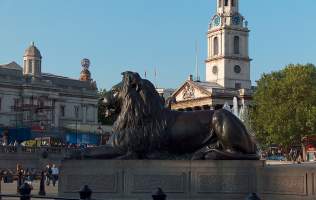
Statues and sculpture of lions are the most familiar animal statues in Britain, with their symbolism of empire, strength, and bravery. The most famous British lion statues are of course Landseer’s lions in Trafalgar Square, four great beasts which took an inordinately long time to make, but since have joined the symbols of the capital - one of them is shown above. Reminiscent of the Trafalgar Square lions, on smaller scale but still very large, are the ones outside Leeds Town Hall, by William Keyworth, and those by St George’s Hall Liverpool, by the sculptor W. G. Nicholl. These two, in stone, typify the seated lion, front paws outstretched, tail coiled round, which is one of the most frequent poses of the sculptured lion – in heraldry it would be the lion couchant. An early pair, much decayed in a rather spooky fashion, are the Buckingham Water Gate lions on the Victoria Embankment, and one of these is shown below. Other examples in London include, for example, one of earlier date at the Customs House on Lower Thames Street; and the Chiswick House lions, male and female, with both back paws on the one side and tail tucked underneath. There are any number of Victorian seated lions; I particularly like the cast ones to be found on the bridge in Rochester, below right.
Examples of seated lion sculpture in Leeds, Liverpool, London (Victoria Embankment) and Rochester. 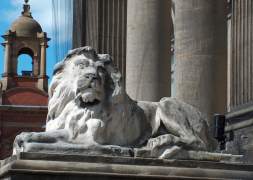
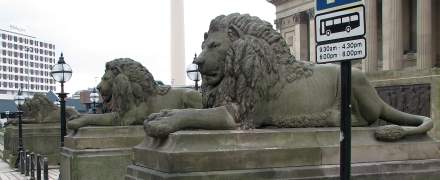
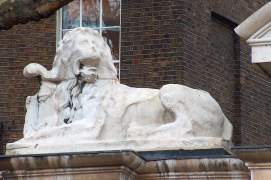
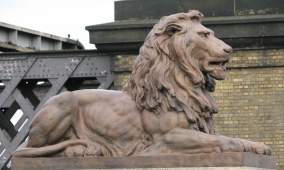
We should mention a subclass of the seated lion sculpture, not so common, where the lion’s head sinks down upon his paws, popularised by Canova, also known from heraldry as the lion dormant. Below left is a woodcut showing Canova's lion at Chatsworth, and to the right is a cast lion, clearly based on it, in Aylesbury.
We have another subclass of the seated lion, which is where a female figure is sitting on top of the lion, or leaning against him. Often she is Britannia, who naturally associates with a lion, and the Britannia page of allegorical statues on this site has three examples, and the Warrior Women page has a couple more. Below is a figure who looks more like Peace in Victory, by the sculptor Marochetti, at Waterloo Place, part of the Lord Clyde monument – what a splendid lion, and the feminine figure no less so. A nude girlish figure on a lion, however, is never Britannia, but generally Una. (Una and the Lion, from Spenser’s Faerie Queen). Several sculptors made a sculptural group of Una and the Lion, as a more exotic variation on the equally appealling theme of Lady Godiva. The three most popular, judging by the number of miniature Parian porcelain versions to be seen in museums and antique shops, are by John Bell, E. H. Baily, and John Thomas.
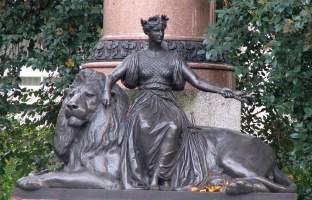
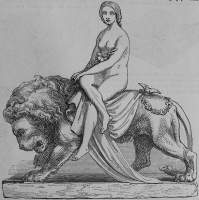 Girls seated on lions, by Marochetti and John Bell.
Girls seated on lions, by Marochetti and John Bell.
Our second leonine pose is the pacing lion, and in this group we may include the standing lion, because generally a standing lion is shown with front feet parallel, but back ones still apart, as if he was walking, and has paused, rather than in some static pose. The pre-eminent example of the pacing lion is in Reading – the giant Berkshire Regiment Afghan Memorial lion, a fierce, snarling beast with realistic head and mane, with the body thick with highly stylised muscles – the chief sculptural production of the sculptor G. Simonds.
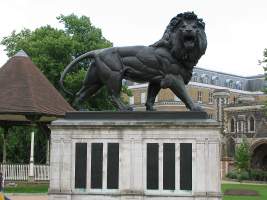 Simond’s lion for the Berkshire Regiment – a beast of prodigious size.
Simond’s lion for the Berkshire Regiment – a beast of prodigious size.
There are four great pacing lions as part of the Victoria Memorial in London, the gift of New Zealand, made like the rest of the sculpture by Thomas Brock. Like much of Brock’s work, they convey a solidity and mass larger than their already considerable size. Their poise, too, is excellent, with a restrained power and a underlying savagery expressed in the narrowing of the eyes and the whip of the tail. A very large example of a standing, or paused lion is the great Coade Stone one on the South Bank by Westminster Bridge, and as with seated lions, there are a goodly number of others to be found across the country, freestanding or in an architetural setting, as depicted below.
Two of the Victoria Memorial lions, flanked by typical smaller examples; and the South Bank Coade Stone lion. 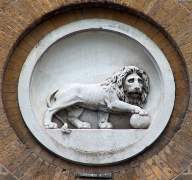
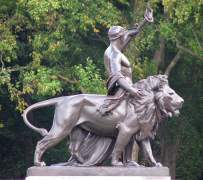
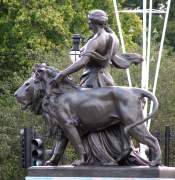
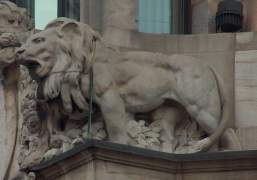
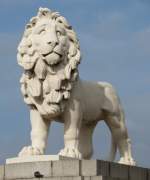
Our third pose, less common, is the lion sejant, seated on the haunches, with front legs vertical, as if an Egyptian cat. From this it is a short step to the rearing heraldic lion with forepaws on a shield, or with whole body raised up paws outstretched to claw – the lion rampant, or if the paws are together, lion salient.
Another group of lion sculptures, which would be as groups for display rather than architectural or as part of an ensemble, is the fighting lion. There is a vivid example of a lion fighting a man on display in London zoo, Negro fighting a Lioness, by Henri Teixeira de Mattos – with a cub on the ground and some doubt as to where the sculptor wishes the viewer’s sympathies to lie. Otherwise, we may find allegorical lions slaying snakes – allegorical of Bravery overcoming Treachery, as on the war memorial below centre, and destroying other hapless creatures, as symbols of British victory over traditional European foes, example below right.
Among mythological beasts, the winged lion is a not uncommon sculptural addition to buildings of Victorian times, and again in heraldry. Below are a few examples. The first two have a tendancy to the heraldic, with an excellentl ferocious pair in terra cotta, and a whole pride supporting a bowl, and having horns as well as wings. Next is a contrasting brick panel, art nouveau with a disturbing tendency to the grotesque. Then one subordinated to part of a decorative scheme to the point where the rear body is entirely foliated; a not unpleasing composition deriving from Contintental baroque forebears, especially as woodcuts, but also, for example, as carved wooden furniture appendages. The example on the far right shows a winged lion as an architectural bracket, rather reminiscent of the angel brackets in churches, and in the style of carved wooden brackets found from time to time on Tudor houses. I like these things, and there are other examples elsewhere on this site.
Lions’ heads are a popular architectural device and form our last group. The number and variety are quite remarkable, and the difficulty is to keep the number of examples here to a manageable number (see a less manageable number on this page). Particularly popular are the ones with rings in their mouths, as on the Victoria and Albert Embankments, and the use of lion’s heads as keystones (there is a page on keystones in general here). The example on the bottom right, where the lions' heads bite on rings from which hang flowers and fruits, is from the charming Stepney Green Clock Tower.
Finally, a personage wearing a lionskin, with the head open-mouthed as a cowl, has been a symbol of authority and strength from Roman times, or of even more antiquity, may indicate Heracles and the Lion, as in the splendid keystone below centre. The pelt may be affixed by tying the legs round the front, as in the example on the left.
Visits to this page from 17 May 2014: 7,974 since 19 October 2022
Lion head sculpture // Eagle sculpture // Other animal sculpture // Sphinx sculpture // Allegorical sculpture // Britannia statues